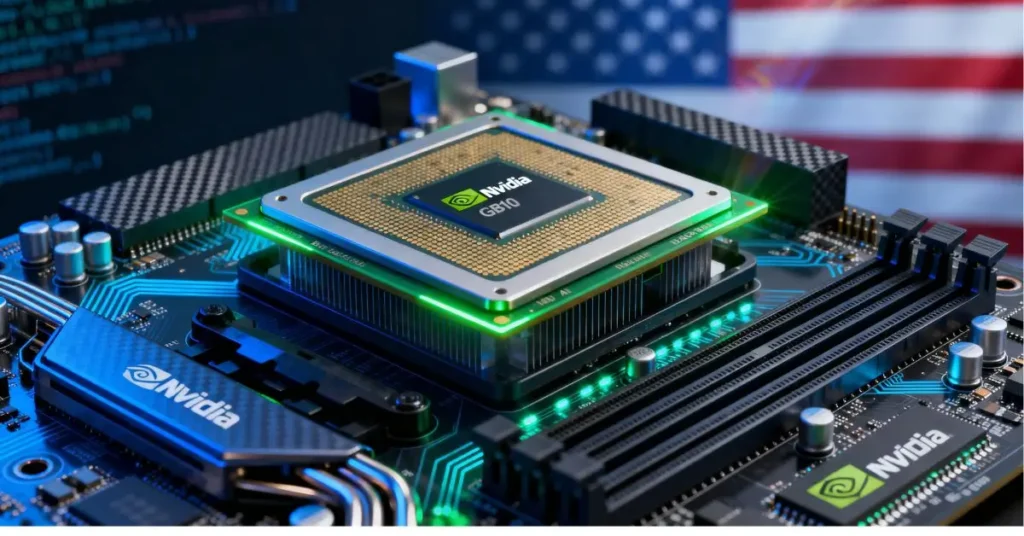
Summary
The United States has drawn a sharp technological boundary in the global AI race. President Donald Trump announced that Nvidia’s latest Blackwell AI chips (GB10 series), the world’s most advanced AI processors, will no longer be available to China or any non-U.S. buyers.
This decision marks a new era of American dominance in artificial intelligence hardware, with significant implications for the global semiconductor supply chain, AI startups, and national security policies.
Introduction: The Breaking Point in the AI Chip War
The 2025 U.S and China AI rivalry has entered a critical stage. In an interview on CBS’s 60 Minutes aired on November 3, 2025, President Trump stated:
“We are not letting anybody have them only the United States will use Nvidia’s top chips.”
These few words shook the world’s tech markets. Nvidia’s Blackwell series, including GB200 and GB10, serves as the backbone of modern AI systems, such as OpenAI’s GPT models, Google Gemini, and Anthropic’s Claude.
Restricting their export means the U.S. is now locking AI supercomputing power inside its borders, giving American companies a decisive head start.
What Are Nvidia’s Blackwell AI Chips?
The Engine of Next-Gen Artificial Intelligence
Nvidia’s Blackwell architecture represents the second generation after “Hopper.”
These chips’ power:
- Large Language Models (LLMs)
- Agentic AI systems
- Autonomous robotics
- Defense and intelligence simulations
Technical Overview

| Feature | Nvidia GB10 / GB200 | Previous Hopper (H100) |
|---|---|---|
| Architecture | Blackwell | Hopper |
| Process Node | 3 nm TSMC | 5 nm TSMC |
| AI Performance | 3× faster training speed | Baseline |
| Energy Efficiency | 2.5× better | Moderate |
| Memory Bandwidth | 8 TB/s | 4 TB/s |
| Supported Models | GPT-5, Claude 3 Opus, Gemini 2 | GPT-4, Claude 2 |
In essence, the Blackwell chips are the beating heart of modern AI infrastructure. Whoever controls them controls the pace of innovation.
Why Trump’s Ban Matters?
National Security Meets Silicon
The White House described the move as an “AI defense measure,” emphasizing that unrestricted access to chips could enable adversaries to build advanced, military-grade AI.
The policy echoes the Cold War-era technology embargoes, but this time the weapon is data processing.
Economic Stakes
- Nvidia’s stock initially surged but then dipped due to concerns about reduced foreign sales.
- U.S. AI firms, such as OpenAI, Anthropic, and Palantir, stand to benefit from exclusive access.
- China’s AI labs (e.g., Baidu, SenseTime, iFlyTek) will be forced to rely on less efficient local chips, such as Huawei’s Ascend 920 B, due to the ban.
The Geopolitical Shockwave
U.S. Strengthens Its AI Leadership
By controlling chip exports, the U.S. essentially:
- Monopolizes next-generation AI computing power
- Protects domestic startups from global competition
- Enhances national data-security resilience
China’s AI Ecosystem Under Pressure
Analysts from Bloomberg Intelligence predict that:
“China could fall 3–5 years behind the U.S. in AI performance due to hardware limits.”
Without Nvidia’s GPUs, Chinese companies must redesign algorithms optimized for smaller chips, reducing model accuracy and training speed.
How This Impacts American Industry
Boost for U.S. Data Centers and Cloud Providers
Major companies like:
- Microsoft Azure
- Amazon AWS
- Oracle Cloud
- They are already scaling infrastructure with Nvidia’s Blackwell chips for enterprise AI.
Expansion of Domestic Manufacturing
The restriction policy aligns with the CHIPS and Science Act, encouraging Nvidia to:
- Build U.S.-based fabrication units
- Partner with Intel and TSMC Arizona
- Support AI-powered renewable-energy initiatives
While Nvidia faces export bans on its Blackwell AI chips, the company continues to strengthen its ecosystem through powerful tech collaborations.
Check Out: how Broadcom and Nvidia are teaming up with VMware Cloud to revolutionize AI infrastructure in 2025. A partnership that’s redefining cloud-based intelligence across the U.S. and Canada.
Advantages and Disadvantages of the Nvidia Export Ban
Advantages
- Strategic Control: Keeps AI power concentrated within U.S. borders
- Innovation Acceleration: Domestic firms get first access to advanced chips
- Security Assurance: Reduces AI misuse by hostile entities
- Job Creation: Expands AI manufacturing, R&D, and data-center roles in the U.S.
Disadvantages
- Market Loss for Nvidia: China was a major buyer (≈ 20 % of revenue)
- Global Supply Imbalance: AI startups outside the U.S. face severe delays
- Retaliation Risks: China could restrict rare-earth minerals essential for chip production
- Inflation Pressure: Higher cost of cloud computing for international customers
Comparison: U.S. vs China AI Hardware Readiness (2025)
| Category | United States | China |
|---|---|---|
| Top AI Chip | Nvidia Blackwell GB10 | Huawei Ascend 920B |
| Process Node | 3 nm | 7 nm |
| Training Speed | 3× faster | Moderate |
| Energy Use | Low | Higher |
| Software Ecosystem | CUDA, PyTorch, TensorFlow | PaddlePaddle, MindSpore |
| Access to Cloud | Azure, AWS, Oracle | Alibaba Cloud, Baidu AI Cloud |
| Global Partnerships | OpenAI, Anthropic, Meta | Baidu, iFlyTek, SenseTime |
This table highlights the significant advancements the U.S. has made in computational infrastructure.
Market and Industry Reactions
Nvidia’s Official Statement
Nvidia confirmed it will comply fully with export restrictions, emphasizing:
“We will continue to support our U.S. partners while developing regional solutions that meet government guidelines.”
Wall Street Responds
- NVIDIA’s stock dipped 4 % post-announcement
- Palantir, Microsoft, and Oracle rose 3–5 % on expectations of expanded domestic demand
- Semiconductor ETFs signaled short-term volatility but long-term bullish trends
Silicon Valley Analysts’ Take
Experts from Stanford and MIT Technology Review describe this as:
“The formal decoupling of global AI hardware, a point of no return.”
Long-Term Implications for AI in the USA
Rise of AI Sovereignty
The U.S. now effectively ensures that its AI models run on American-controlled hardware.
This helps us:
- Improve AI transparency and safety
- Foster Agentic AI innovations
- Reduce dependency on global supply chains
Potential Expansion
If the restriction extends to Europe or the Middle East, U.S. allies may get limited-edition Blackwell variants, creating a two-tier AI economy.
Expert Opinions Here:
Tech Analysts
“It’s not just an economic move; it’s a strategic message whoever leads in compute, leads in AI.”
Dr. Sarah Lin, MIT AI Policy Center
Nvidia’s CEO Jensen Huang
“We respect U.S. policy and remain committed to pushing the limits of AI innovation responsibly.”
The Future: What’s Next After Blackwell?
Nvidia is rumored to be developing Project Rubin, the successor to Blackwell, which is expected to be released in 2027.
Meanwhile, companies like AMD, Intel, and Cerebras are preparing alternatives to ensure a diversified AI chip ecosystem in America.
Conclusion
marks one of the most decisive turning points in the history of technology policy. The U.S. now leads the world in AI hardware, ensuring its dominance in national defense, innovation, and the commercial AI sector.
While it may ignite geopolitical tension, it also cements America’s position as the world’s AI powerhouse. In this new era of digital competition, AI hardware isn’t just technology; it’s a matter of sovereignty.
Despite political restrictions, Nvidia’s innovation journey continues. For a broader view of how the company is expanding its AI footprint, don’t miss our deep dive on Broadcom and Nvidia’s VMware Cloud AI integration in 2025: Story of resilience, collaboration, and next-gen computing power
FAQs
Q1. Why did Donald Trump ban Nvidia’s Blackwell AI chips for China?
Answer: Trump banned the export to prevent China from accessing advanced U.S. AI hardware that could boost its military and tech dominance. It’s part of America’s AI security policy.
Q2. What is Nvidia’s Blackwell AI chip?
Answer: Nvidia’s Blackwell is a next-generation AI processor designed for large language models and data centers, offering significant performance and energy efficiency gains.
Q3. Will Nvidia still sell AI chips to other countries?
Answer: Yes, Nvidia can sell downgraded versions to allied nations like South Korea, but full Blackwell chips are restricted to U.S. use only.
Q4. How does this ban affect China’s AI industry?
Answer: The ban slows China’s access to cutting-edge AI computing power, forcing it to rely on local chip development and weaker alternatives.
Q5. How will this move impact the U.S. AI sector?
Answer: It strengthens U.S. AI dominance by ensuring that top technology stays within American companies and research labs.
Q6. Is Nvidia losing revenue because of the ban?
Answer: In the short term, yes — China was a major buyer. However, U.S. government contracts and domestic AI demand could offset that loss.
Q7. What does this decision mean for global AI competition?
Answer: It deepens the tech divide between the U.S. and China, making AI hardware a new frontier of geopolitical power.
Q8. Could China develop its own alternative to Nvidia chips?
Answer: China is investing heavily in local semiconductor firms, but catching up to Nvidia’s technology could take years.
Q9. How are American tech companies reacting?
Answer: Most U.S. firms support the decision, seeing it as protection for national interests and intellectual property.
Q10. What’s next for Nvidia after this ban?
Answer: Nvidia plans to expand U.S.-based production and invest in AI software to reduce dependence on foreign chip markets.


